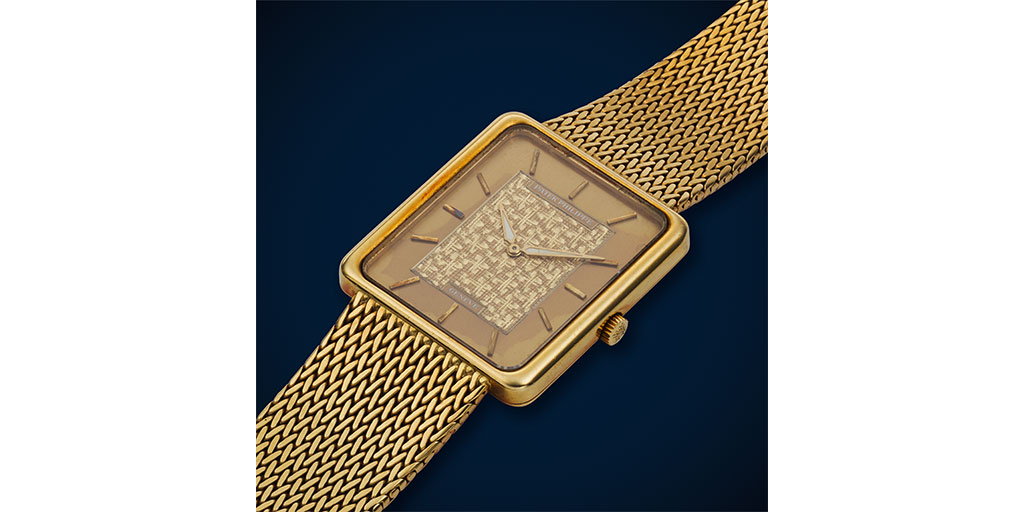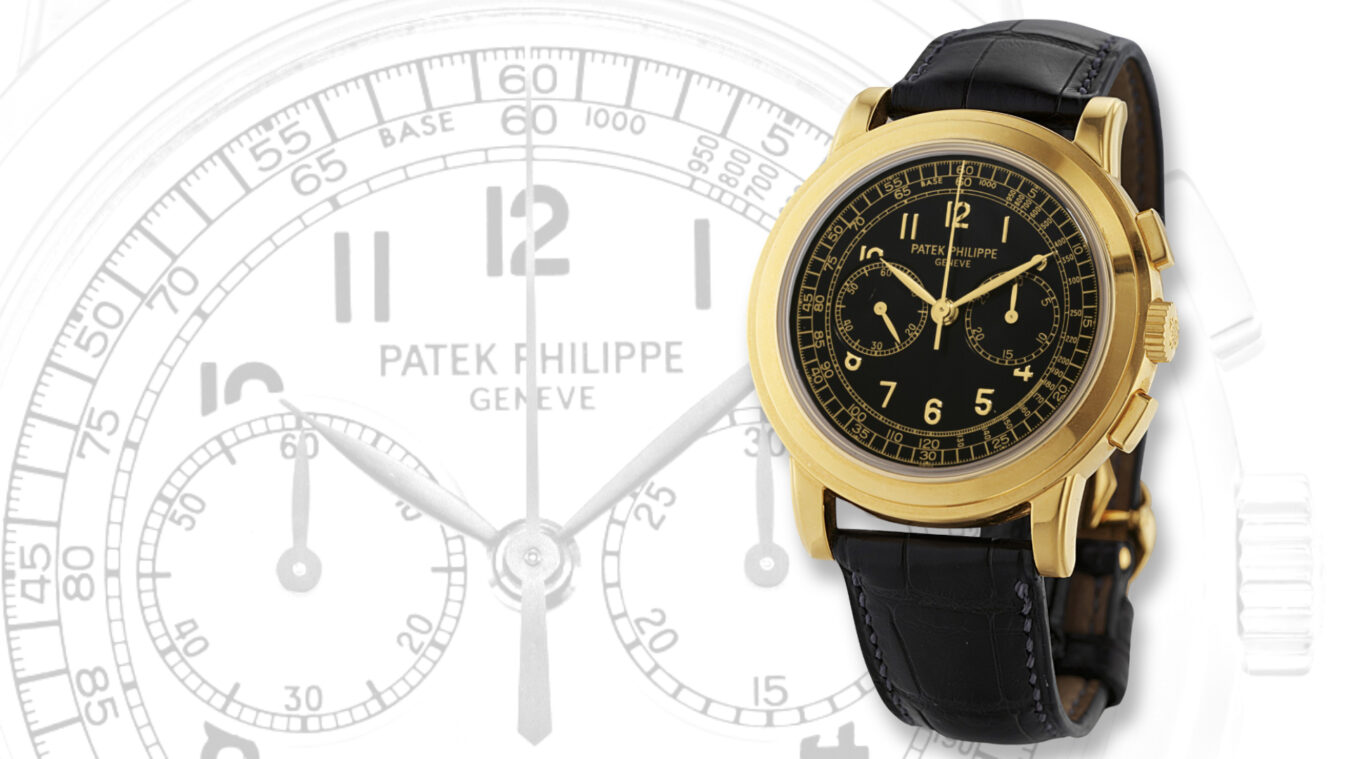Not a week goes by without someone asking us for a gold, mesh bracelet Patek Philippe. This is a new phenomenon. Not so long ago, people would not give a mesh bracelet watch a second look, and consequently, they were (and still are) some of the best value Patek Philippe watches. What has happened? Could it be the ‘Harry Styles-effect’? First, he brings back blouses for men (not since the British New Romantic era of the 80s have men felt so embolden with their fashion choices), and subsequently, anything with a 70s aura seems simply the right thing to wear. Perhaps this is a reason why we are beginning to see an increase in interest in watch design from the 1970s? There is certainly a need to embrace the 70s aesthetic, as Brynn Wallner, founder of DIMEPIECE noted on a recent interview on the Viva Bastardo Show, “guys are trying to dress like Harry Styles but wear a Sub-Mariner”. These large, hyper-masculine, sports watches that men have been wearing for the past decade, do not go with the current androgynous style. But Patek Philippe watches from the 1970s do, and just as with the blurred lines in fashion, these watches can be worn by men or women.

Two of the most iconic designs from the 1970s have already made their mark over the last few years, the Nautilus and the Ellipse. But just like the fashion of the 1970s, Patek Philippe watches are very distinctive from this period. As Phil Toledano recently said in an interview with WatchBox Studios where he discusses his passion for collecting Patek Philippe watches from the 1970s, “I love the audacity of 70s Patek, I love the integrated bracelets, I love that people weren’t paying attention to them, and I also love that in the context of Patek, they are massive bargains.” Tim Mosso very succinctly observed in the same interview that Patek Philippe watches from the 1970s are like a “horological Australia” because there are watch designs from that era that exist nowhere else in Patek Philippe’s design catalog.

The 1970s was a period when watch designers and jewelers worked hand-in-hand. Mesh bracelets from this period are works of art that we simply do not see today. As the disco-era inspired people to express themselves on the dance floor, watch design was equally creative. There were no rules for watch design, anything went, and both men and women were happy to wear solid gold bracelet watches, often richly adorned with jewels or engraving. This was a period of form shapes and integrated bracelets. A good example of a classic, integrated bracelet can be seen in the ref. 3729G above in which the ‘Tubagaz’ design of the bracelet perfectly molds with the stepped bezel of the Ellipse-inspired case. The clean, black onyx dial with no hour markers seals the 70s aesthetic. Watch movements tended to be simple — complications don’t work so well on clean design and sculptural shapes — the design and decoration were what mattered.
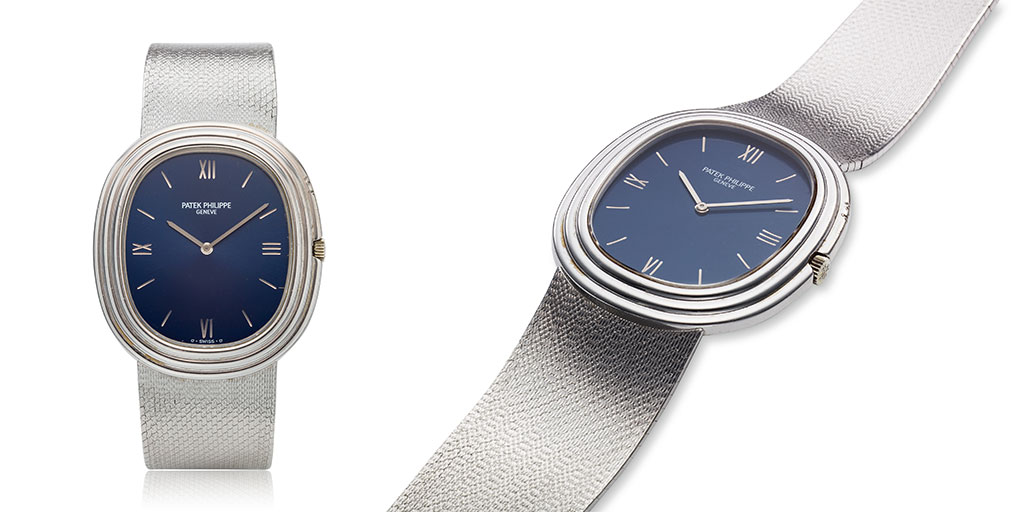
The 1970s was also a time of significant change in the watch industry: quartz technology was advancing timekeeping in an unprecedented manor. Patek Philippe was making its own significant strides in electronic technology and one of its first quartz wristwatches was the now iconic, Beta 21 ref. 3587. The massive, 43 mm two-piece cases of the ref. 3587 were made by Atelier Réunis (casemaker mark 28). These were the biggest wristwatches made by Patek Philippe in the 20th century. It was not until the dawn of the 21st century that we started seeing cases of this size and larger from Patek Philippe. Atelier Réunis made some of the most important cases for the manufacture during this time and it is a structural design achievement to integrate such a large, heavy case with such a fine mesh bracelet.
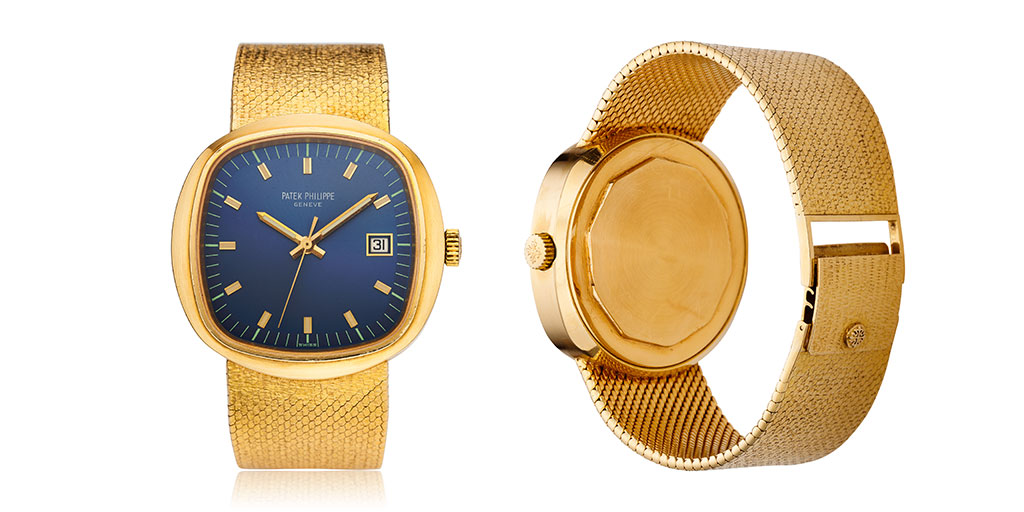
Mesh bracelets feel sensational on the wrist and are almost fabric-like in their fluidity. Although not practical in terms of re-sizing — once they are cut to fit, they cannot be extended if needed — their comfort on the wrist is both decadent and practical. So finely made are these mesh bracelets that they don’t tag even the finest silk chiffon (useful for blouses), or nick a stray hair on the wrist. Each bracelet was hand-finished by some of the greatest artisans. Makers such as Jean Pierre Eccofey, Gay Fréres, Ponti Gennari and Cornu & Cie each mastered the art of fine mesh bracelets and worked with pride for Patek Philippe.
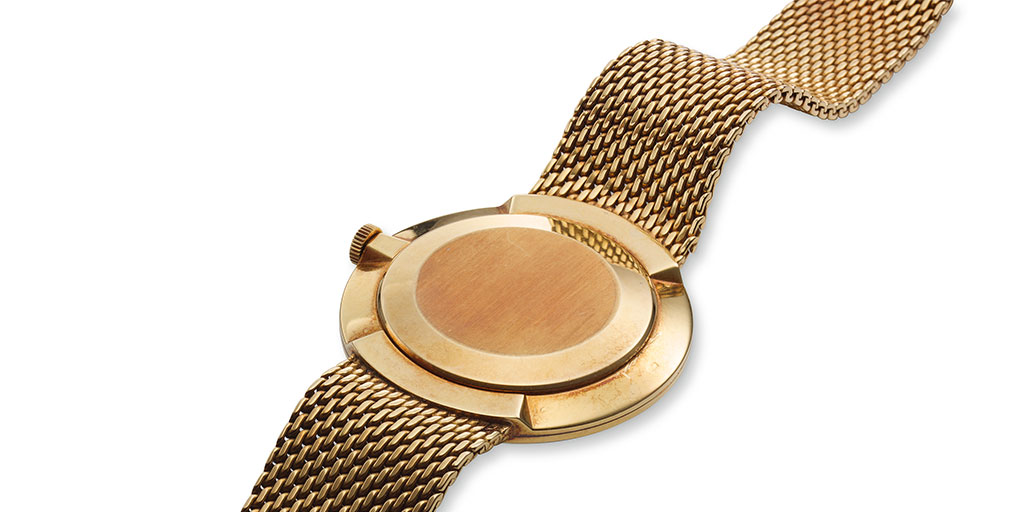
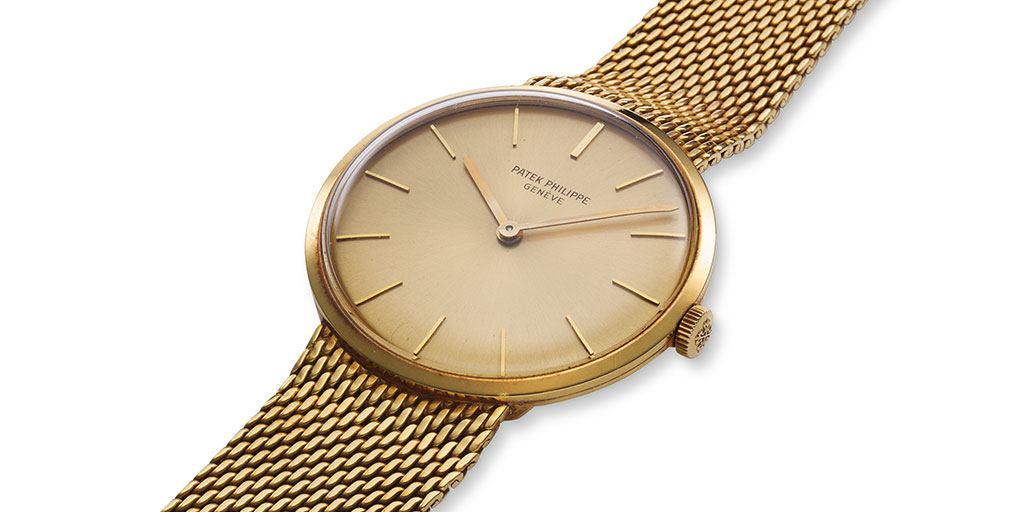
Although the hobnail bezel did not become an iconic design in the Patek Philippe catalog until 1985 with the introduction of the ref. 3919, the Patek designers were playing with this striking design in the 1970s and recognized how it complemented the mesh bracelet craze. In the stunning example below, we see a ref. 3781/1J that turns the Ellipse on its side and adorns the unusual shape with graduating sequences of hobnail engraving. In order to achieve such perfect design gradients on the bezel, the pattern was engraved by hand. The result is a unique watch case that perfectly complements the mesh bracelet.

Fine mesh was not the only type of bracelet popular in the 1970s. Just as jewelers were experiencing a renaissance of their skills, the chainsmiths were enjoying an appreciation of their craft in all its variations. The Ellipse collection benefited from a wealth of wonderful bracelet designs, many of which, even if initially made for men, can also be worn by women. The Ellipse ref. 3848/1G below is a good example of a truly androgynous style. Its 32 mm x 27 mm case and solid gold bracelet is so brilliantly hand-crafted and flexible that it fits comfortably on any wrist. Using only a pair of pliers and their hands, chainsmiths are able to fashion strings of gold into luxurious, complicated patterns that can weather changing fashions with their timeless beauty.

For ladies watches, the 1970s was also a time of experimental design, particularly with the use of precious and semi-precious stones such as coral, turquoise and lapis lazuli. Inspired by master jeweler Gilbert Albert who looked to nature for unusual decorations, even butterfly wings found a place on dials and bracelets. Below is a beautiful piece which can be seen in the Patek Philippe Museum, a treasure trove of rare and unique watches.
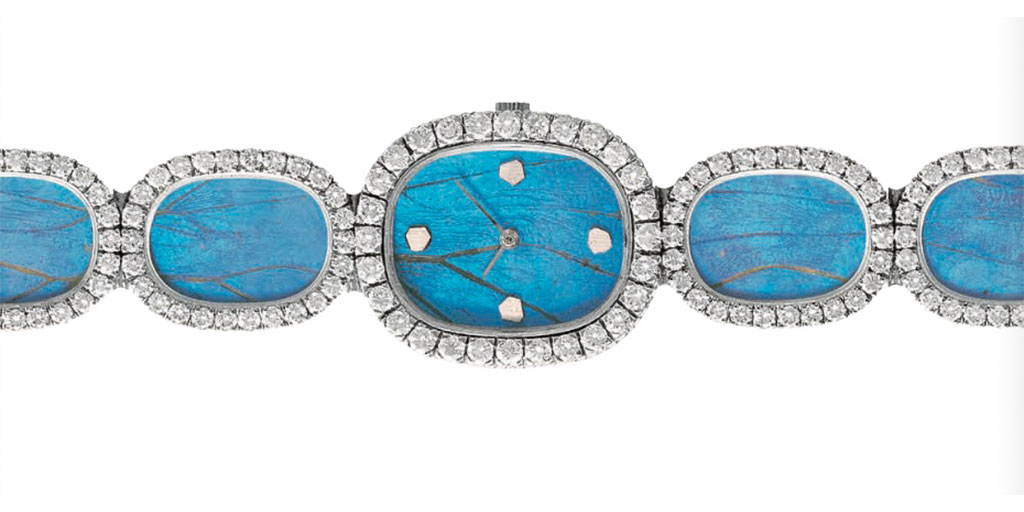
A stunning example that we recently found is the ‘Golden Circle’ below. This museum-quality ref. 4128/1 is a work of the jeweler’s art that we have not seen before – and typical of this period when Patek Philippe was pushing the boundaries of decorative watch design. The Archive-confirmed, sunburst satin-finished cobalt blue dial is surrounded by 16 flawless, round cut diamonds. Definitely a watch for the jetsetter.
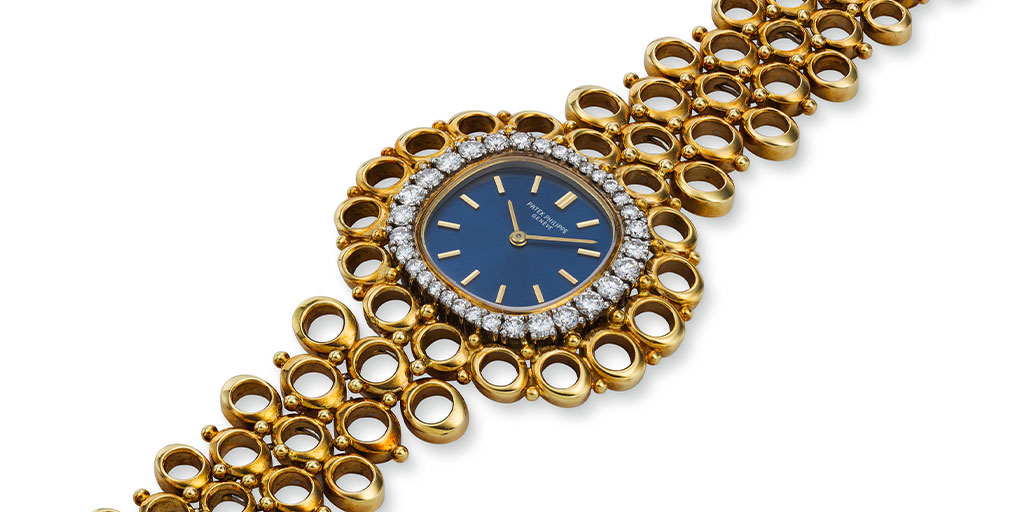
In the 1970s, Patek Philippe worked with the jewelry designer Georges L’Enfant who made a line of disco-era necklaces depicting astrological signs. The distinctive chains were textured and finished to the highest standards. Patek embraced L’Enfant’s unique style in a small series of ‘joaillerie’ watch creations such as the exquisite ref. 4920/2J below made in 1974. Featuring a horizontal Ellipse case with a Stern Frères lapis lazuli dial and a bracelet of braided gold links of a stunning geometric design, this watch is a rare testament to Patek’s exploration of texture and form in the 1970s.
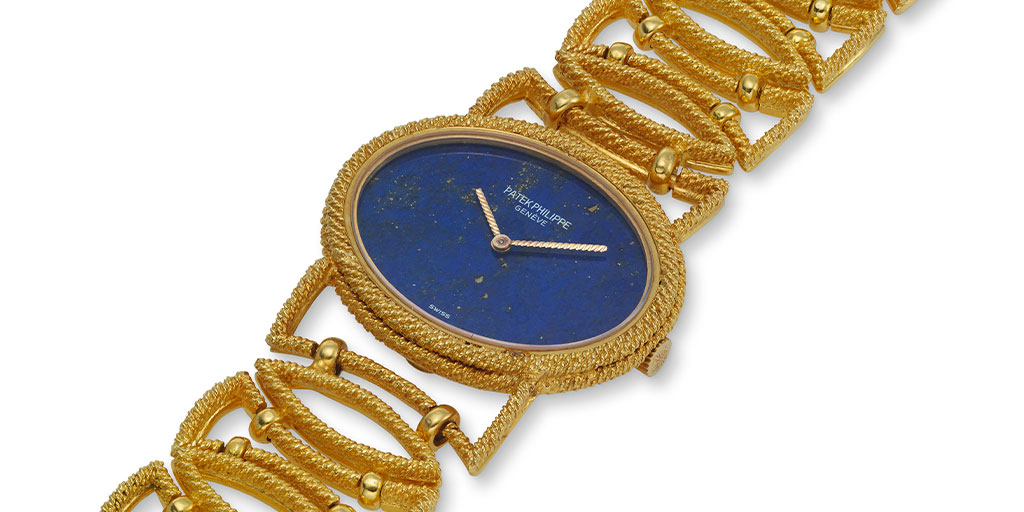
The 1970s was a time of excessive glamour and matching sets of a watch, earrings and a ring were the vogue. Special order ladies jeweled sets from Patek Philippe stretched the limit of the imagination, and the technical brilliance of the jeweler. The ref. 4361/3J below is a masterful triumph of 1970s design and execution. Made in 1976, the lapis lazuli dial is repeated through the heavy gold links of the bracelet, the earrings, and the ring. Note how the delicate twists of gold decorating the watch and jewelry is repeated in the hands of the dial.
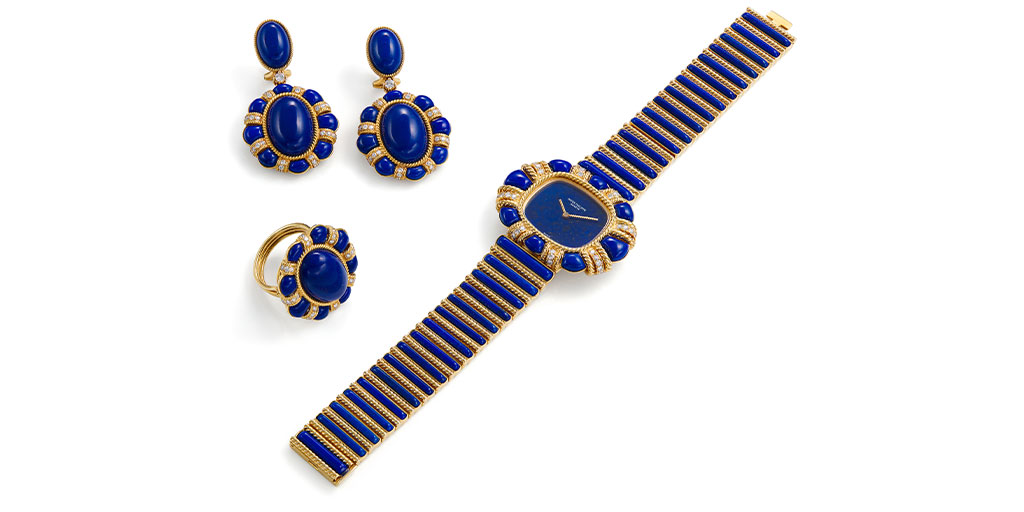
Even though we are seeing an uptick in demand for Patek Philippe watches from the 1970s, they still offer good value for money. The level of the craftsmanship and the quality of the materials used to make these pieces cannot be replicated today at similar price points. As we observe more men embracing design and celebrating originality rather than just following trends such as wearing steel sports watches, we can look forward to a renaissance of watch design. Equally, we are seeing more women appreciating the joy of wearing a stunning piece of jewelry that also accurately tells the time.

